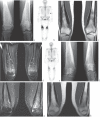SAPHO syndrome--a pictorial assay
- PMID: 23576940
- PMCID: PMC3565401
SAPHO syndrome--a pictorial assay
Abstract
SAPHO (synovitis, acne, pustulosis, hyperostosis and osteitis) syndrome is a distinct clinical entity representing involvement of the musculoskeletal and dermatologic systems. It is well known to rheumatologists because of characteristic skin manifestations and polyarthropathy. However, few reports exist in the orthopaedic literature. It is important to be aware of sAPHO syndrome as it can mimic some of the more common disease entities such as infection, tumor, and other inflammatory arthropathies. Anterior chest wall pain centered at sternoclavicular and sternocostal joints is an important and characteristic clinical finding which can point to its diagnosis. A patient may undergo different diagnostic tests and invasive procedures such as biopsies before a diagnosis is made. Imaging can be helpful by offering a detailed evaluation of the abnormalities. More importantly it helps in revealing subclinical foci of involvement due to the polyostotic nature of the disease. The treatment is mostly nonsurgical. NSAIDS are the first line agents. However multiple new agents are being used for refractory cases. Surgery is reserved to treat complications.
Figures




References
-
- Windom RE, Sandford JP, Ziff M. Acne conglobata and arthritis. Arthritis Rheum. 1961;4:632–635. - PubMed
-
- Chamot A, Benhamou CL, Kahn MF, et al. Le syndrome acne pustulose hyperostose osteite (SA-PHO) Rev Rhum. 1987;54:187–196. - PubMed
-
- Jang KA, Sung KJ, Moon KC, Koh JK, Choi JH. Four cases of pustulotic arthro-osteitis. J Dermatol. 1998;25(3):201–4. March. - PubMed
-
- Hyodoh K, Sugimoto H. Pustulotic arthro-osteitis: defining the radiologic spectrum of the disease. Semin Musculoskelet Radiol. 2001;5(2):89–93. Jun. - PubMed
Publication types
MeSH terms
LinkOut - more resources
Full Text Sources
